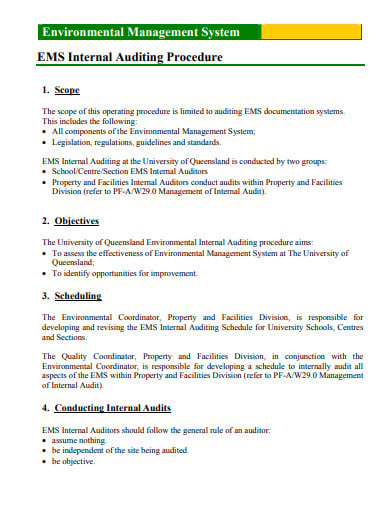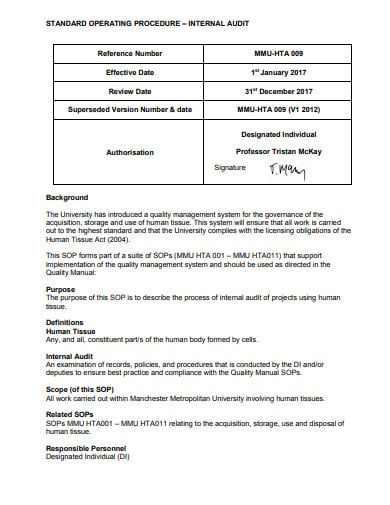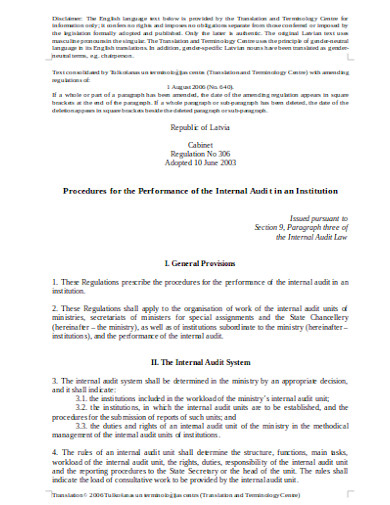Table of Contents
- 1. Sample Internal Audit Procedure Template
- 2. Internal Audit Policies & Procedure Layout
- 3. EMS Internal Audit Procedure Template
- 4. Internal Quality Chart Audit Procedure Format
- 5. Human Research Internal Audit Procedure
- 6. Internal Audit Operating Procedure Example
- 7. Internal Audit Standard Operating Procedure
- 8. Basic Internal Audit Procedure in PDF
- 9. Printable Internal Audit Laboratory Procedure
- 10. Internal Audit Procedure in DOC Format
- 11. Internal Audit Method & Procedure Download
- 12. Internal Audit Performance Procedure Template
- What Should You Include in an Internal Audit Procedure?
- What do Internal Auditors Do?
- Why Do Organizations Need Internal Audit?
Internal Audit Procedure
The main purpose of an internal audit procedure is to provide a written summary of the audit processes. This useful document helps in laying out all of the necessary processes that should be performed before or during and after an internal audit. It serves as a major benefit to you and your business if you have such an important document on-hand. An appealing internal audit procedure can be a very useful guide for all parts of an audit from the beginning to the end.

1. Sample Internal Audit Procedure Template
 ksu.edu.sa
ksu.edu.sa2. Internal Audit Policies & Procedure Layout
 cccd.edu
cccd.edu3. EMS Internal Audit Procedure Template
 cws.auburn.edu
cws.auburn.edu4. Internal Quality Chart Audit Procedure Format
 hlurb.gov.ph
hlurb.gov.ph5. Human Research Internal Audit Procedure
 dfhcc.harvard.edu
dfhcc.harvard.edu6. Internal Audit Operating Procedure Example
 sustainability.uq.edu
sustainability.uq.edu7. Internal Audit Standard Operating Procedure
 mmu.ac.uk
mmu.ac.uk8. Basic Internal Audit Procedure in PDF
 cstools.asme.org
cstools.asme.org9. Printable Internal Audit Laboratory Procedure
 finddx.org
finddx.org10. Internal Audit Procedure in DOC Format
 who.int
who.int11. Internal Audit Method & Procedure Download
 poreskauprava.gov.me
poreskauprava.gov.me12. Internal Audit Performance Procedure Template
 vvc.gov.lv
vvc.gov.lvWhat Should You Include in an Internal Audit Procedure?
It may seem like a complicated task to put together an internal audit procedure, but there are certain points that every procedure should include. You must know these points before you start your internal audit procedure. Some important common elements are included in an internal audit procedure.
-
Scope
First comes the scope of the document which tells what is the purpose of the audit. And when it is an internal audit procedure, the purpose should be to outline the process of an internal audit as it applies to your business. This will generally include guidelines for the stages of the process of internal auditing.
-
Objectives
This portion lists out the objectives that you are hoping to reach by performing an internal audit. It will normally talk about evaluating and finding some evidence of success within a system. It can also include an objective regarding pointing out areas that require a change. This part will contain whatever you are hoping to accomplish through an internal audit.
-
Responsibilities
Make sure you always include who is responsible for conducting the internal audits in your procedure. Try not to put a specific name as you will have to review the document every time there is a change in the position. It is much better to put a job title so that you do not have to worry about any updates in the future. This section should also lay out what exactly they are responsible for.
-
Planning
This section will contain detailed steps that are relevant to the internal audit process or the steps which will be followed during the process of internal audit. It will mainly include a specific way to plan each internal audit and talks about meetings, reviews of any previous audits, drawing up plans, scheduling and what needs to be addressed, etc. Internal audit planning should also walk auditors through the process of getting everything ready to perform the audit.
-
Fieldwork
This is the part where the internal audit is put into action and the procedure will guide the auditors through what needs to be done throughout the internal audit. You can also include any necessary checklists in this section. It is these important guidelines that should be written thoroughly so that they are easy to follow.
-
Reporting
After finishing up the audit, the auditor must create a report of their findings. This portion of the internal audit procedure outlines what are the things that need to be included in the report and go about organizing it. It will ensure that these instructions are done consistently every time.
-
Follow-Up
You can include guidelines for follow-up in your internal audit procedure to make sure that it is being done. This part can outline how and when an auditor can perform a follow-up. The auditor will check to see whether the corrective action has been taken to fix any problems that are found by the internal audit during a follow-up. Lacking a follow-up means these actions might not be taken in regularly as they should be.
What do Internal Auditors Do?
Internal auditors deal with issues that are radically important to the survival and prosperity of any organization. Internal auditors inspect much more than just financial risks and statements to examine wider issues like the organization’s reputation, its growth, its impact on the environment as well as the way it treats its employees, unlike the external audits.
Internal auditors simply help organizations to succeed and this is done through a combination of assurance and consulting. The assurance part involves telling the managers and governors how well the systems and processes designed to keep the organization on track. After this, consulting is offered which helps in improving those systems and processes where necessary.
Why Do Organizations Need Internal Audit?
Internal audit procedures play an important role in helping executives to reach their conclusions. The efforts made by the internal in identifying the breakdowns in internal controls also help in protecting against potential fraud. This also helps safeguard against any kind of waste or abuse, and ensure compliance with laws and regulations.

